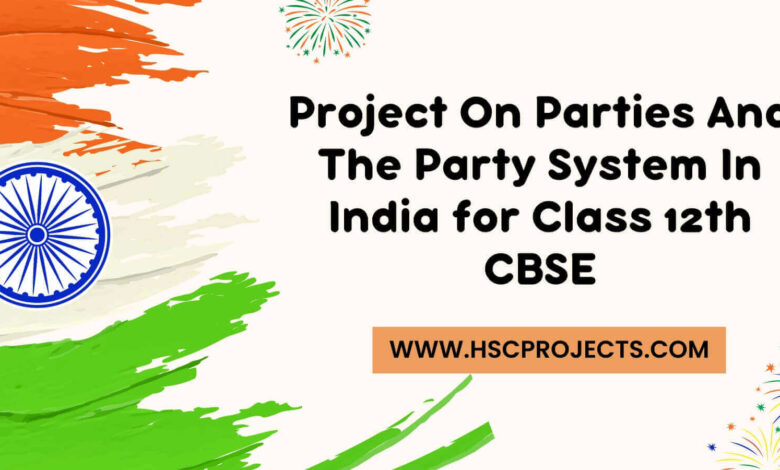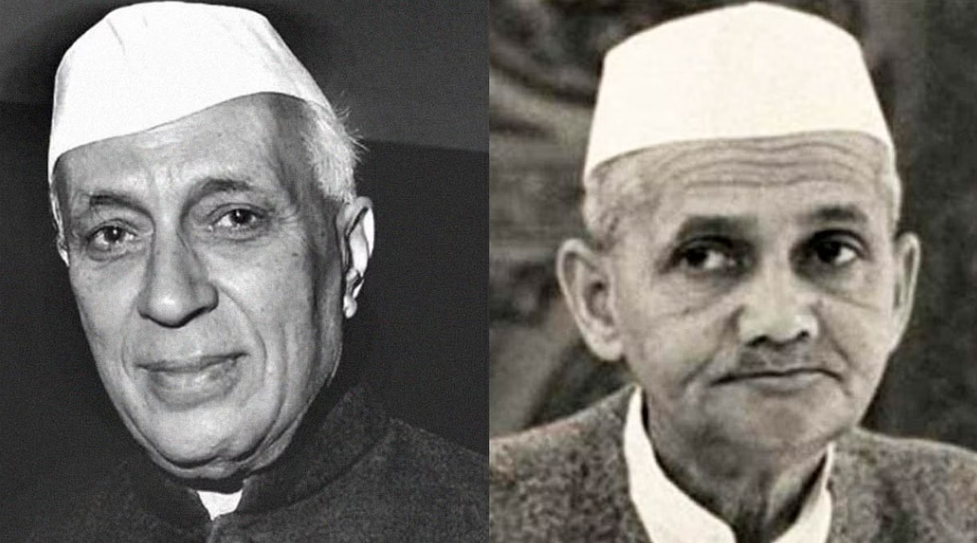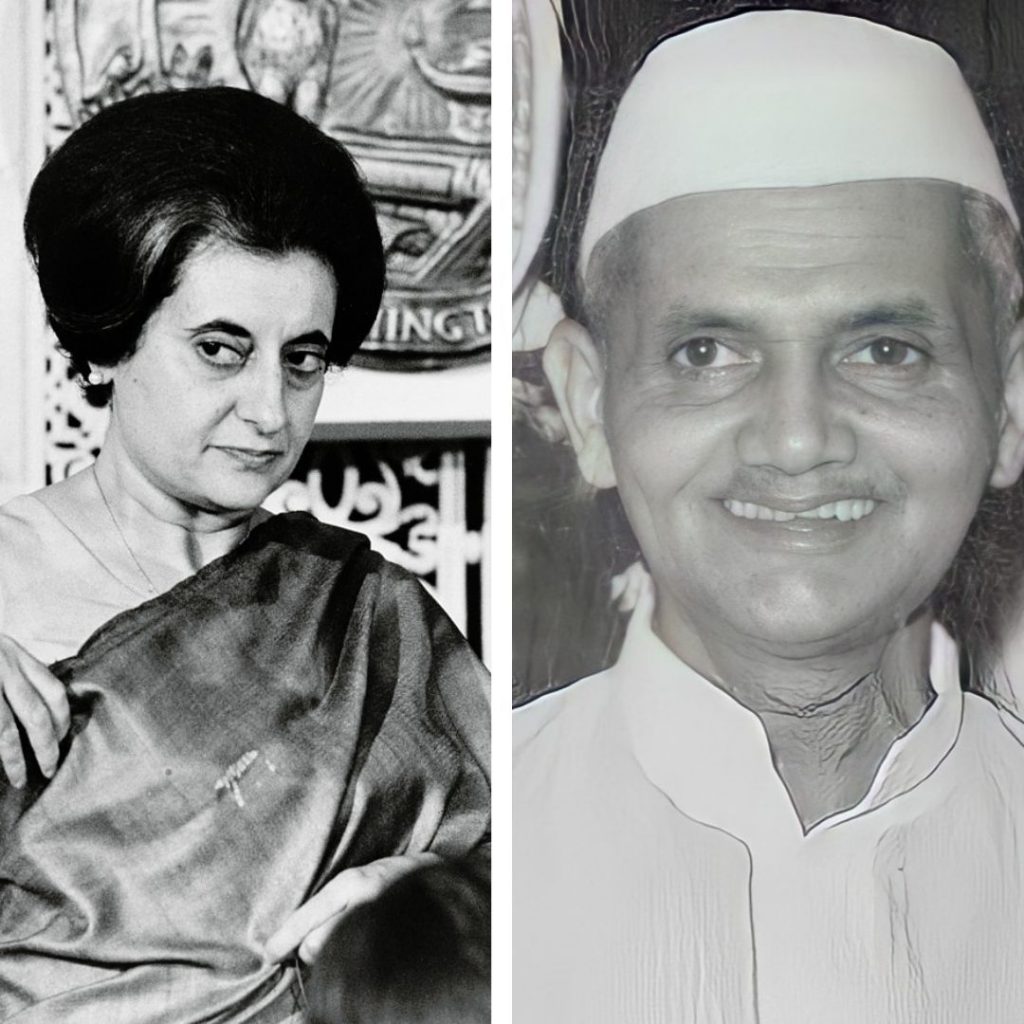
Project On Parties And The Party System In India For Class 12th CBSE
Acknowledgment
Sincere appreciation goes out to my Political Science professor, whose feedback and suggestions were important in helping me refine my thoughts and arguments and ensure the success of my effort.
To my parents, who have always been there for me and given me the tools I needed to succeed in my endeavor, I am eternally grateful.
In addition, I appreciate the help of the librarians in locating the appropriate books and other resources.
Last but not least, I’d want to give credit where credit is due and say how much I appreciate all the online resources and books that helped me complete my paper.
Introduction
As a vehicle for public engagement and representation in government, political parties are an essential component of every functional democracy. Political parties in India, a nation renowned for its robust and varied democracy, have been instrumental in defining the country’s political environment.
There are many different parties at both the national and regional levels in India’s political system. The Indian National Congress was instrumental in India’s fight for independence and went on to dominate Indian politics for decades after the nation gained its freedom. The political scene, however, has changed dramatically in recent years due to the growth of regional parties and the introduction of new political actors.
Challenges Of Political Succession
In India, political parties are struggling with the problem of leadership transition. The term “political succession” is used to describe the passing of the torch from one generation of leaders to the next. Many political parties in India are led by tyrants who have been in control for decades. But when these leaders reach retirement age or beyond, finding suitable replacements becomes more difficult.
The absence of a well-defined and open procedure for choosing a new leader is a major obstacle in political succession. The head of a political party is often selected not on the basis of talent or a democratic process, but rather on the basis of family ties, loyalty, and personal charisma. Because of this, the party may fragment into competing factions as potential leaders struggle for control.
One difficulty with political succession is that parties often don’t have a well-developed ideology or long-term goal. The philosophy or vision of many Indian political parties is represented by a single, powerful figure. There may be a void in the party leadership when this person retires or moves down, making it difficult to find someone who can successfully express the party’s mission and recruit followers.
Last but not least, India’s greater problem with dynastic politics is connected to the dilemma of political succession. The leadership of many political parties is held by influential families who then pass it down through the generations. When members of the same family are promoted to high positions in the party without regard to their actual talent, it may breed a culture of entitlement and a lack of meritocracy.
From Nehru To Shastri

The Prime Minister of India, formerly Jawaharlal Nehru, is widely credited for launching the modern Indian IT industry. This change happened following Nehru’s death in 1964, when Shastri was subsequently elected Prime Minister of India.
During India’s fight for freedom from British colonial authority, Jawaharlal Nehru was one of the most influential personalities on the political scene. He was a forward-thinking statesman who influenced India’s early post-independence economic and political strategies. Nehru’s secular, socialist, and democratic principles informed his leadership style, and he was instrumental in establishing India’s Cold War foreign policy, including its non-alignment attitude.
India’s next prime minister was Lal Bahadur Shastri, who took office after Nehru’s death in 1964. A seasoned politician, Shastri held many cabinet roles under Nehru. He was well admired by the Indian people for his candour, straightforwardness, and honesty. Shastri had several difficulties during his brief time in office as Prime Minister, including the 1965 war between India and Pakistan and a food scarcity. His renowned motto, “Jai Jawan, Jai Kisan,” which celebrated both the Indian military and the Indian farmer, is also associated with him.
As one of India’s most famous leaders, Nehru, handed the reins of government over to a new generation of leaders with the transfer of power from Nehru to Shastri. As India began its complicated post-independence path, a new set of political difficulties and possibilities emerged during this time.
From Shastri To Indira Gandi

Another watershed milestone in India’s political history was the changeover from Shastri to Indira Gandhi. After Lal Bahadur Shastri’s untimely death in 1966, the Indian National Congress, the country’s largest political party, was left without a clear leader. Indira Gandhi, the daughter of India’s first Prime Minister Jawaharlal Nehru, was ultimately chosen as the country’s new leader after extensive political manoeuvring.
When compared to her predecessors, Indira Gandhi’s approach to leadership was quite different. She was a controversial figure in Indian politics due to her reputation as a tough and determined leader. Significant events occurred during Gandhi’s time as Prime Minister, such as the Bangladesh Liberation War, the nationalisation of banks, and the implementation of the Emergency in 1975.
Gandhi’s administration was complicated by the growth of regional political groups in India. Many of these parties reflected the hopes of diverse language and ethnic groups in India, and they developed after the linguistic reorganisation of states in the 1950s and 1960s. Parties like this have stood in opposition to the Indian National Congress by calling for more independence for individual states.
Gandhi also encountered resistance from inside her own party, as competing factions vied for control. After a disagreement with the Indian National Congress in 1969, she started her own political party and named it the Congress (R). This action strengthened her position in government but also revealed the difficulties inherent in navigating the environment of contemporary politics.
In retrospect, India’s leadership change from Shastri to Indira Gandhi was a watershed moment as the nation struggled to maintain stability amidst a fast shifting political environment. In India, Indira Gandhi’s legacy as one of the country’s most notable leaders and her leadership style and policies are still the subject of debate and scrutiny.
Fourth General Election 1967
In 1967, India conducted its fourth general election, which was a watershed moment in the country’s political development. As regional parties in India rose to prominence after this election, the political landscape shifted dramatically. Furthermore, it underlined the Indian electorate’s increasing discontent with the Indian National Congress, the party that has dominated Indian politics since independence.
Many smaller parties, including Tamil Nadu’s Dravida Munnetra Kazhagam (DMK) and Bihar’s Samyukta Socialist Party (SSP), came into prominence after the 1967 election. By capitalising on local concerns, these groups positioned themselves as competitive alternatives to the Indian National Congress. Previously dominated by a single party, India’s political landscape has become more divided and diversified thanks to the success of regional parties.
The Indian National Congress had serious difficulties in the 1967 elections, as its vote share plummeted. The party was criticised for seeming arrogant and complacent, and for failing to understand the concerns of the Indian people. The Indian National Congress engaged in some soul-searching in the wake of the 1967 elections, trying to figure out what had gone wrong and where to go from there.
There was a sea change in Indian politics with the fourth general election that year. It underlined the rising discontent of the Indian voters with the Indian National Congress and signalled the development of regional parties as a strong force in national politics. As a result of this election, regional parties have become more influential in India’s national politics, and their influence has only grown since.
Split In The Congress

In terms of Indian politics, the 1969 schism within the Indian National Congress was a watershed moment. Different groups within the party were vying for leadership positions and ultimately caused the schism. Indira Gandhi and senior party leader Morarji Desai headed the two major groups.
The fallout from the schism inside the Indian National Congress was felt across Indian politics. As a result, Indira Gandhi’s Congress Party and Morarji Desai’s Congress Party split apart. The breakup was also a watershed moment in Indian politics since it signified the beginning of the rise of regional parties.
Ideological disputes between the two sides of the Indian National Congress led to the party’s split. The group led by Indira Gandhi was perceived as more left-leaning and populist because it supported increased government involvement in the economy and a more aggressive foreign policy. The group led by Morarji Desai was more cautious in its approach to foreign policy and more conservative and market-oriented.
There were serious repercussions for Indian democracy as a result of the schism in the Indian National Congress. Because of this, there was a period of political instability as various groups inside the party vied for power. The Emergency was declared in 1975 to put an end to the unrest, during which time civil freedoms were revoked and political criticism was stifled.
In retrospect, the 1969 schism within the Indian National Congress was a watershed moment in Indian politics. It exposed the widening ideological gaps within the Indian National Congress and heralded the rise of regional parties as a significant political force in India. Different groups and regional parties in India are still vying for control and influence thanks in large part to the legacy of this schism.
The 1971 Election And Restoration Of Congress
In terms of India’s political development, the general election that year marked a watershed point. There was a divide in the Indian National Congress at the time, with Indira Gandhi heading the Congress (R) and Morarji Desai heading the Congress (O). Indira Gandhi’s Congress (R) party was declared the winner, with an overwhelming mandate from voters in India.
There were several reasons why the 1971 midterm election stood out. It was the first election conducted following India’s victory in the 1971 Indo-Pakistani War, which ultimately resulted in the formation of Bangladesh. Indira Gandhi’s popularity rose after the war because of the public’s perception of her as a leader who effectively protected India’s interests.
The Indian National Congress’s ascendancy to the position of India’s preeminent political party in the wake of the 1971 election was equally notable. The Congress (R) party, led by Indira Gandhi, won an overwhelming majority of the Lok Sabha’s 518 seats. However, the Congress (O) group lost eighteen seats.
When the Congress was reinstated as India’s ruling party, it was a watershed moment in the country’s history. It was also a turning point in Indira Gandhi’s leadership, as she began to exercise more absolute power from that point on.
The 1971 election was a watershed event in Indian politics since it resulted in the Congress party once again being the country’s primary political party. Indira Gandhi’s charismatic leadership and widespread support helped her party win, demonstrating the power of public opinion in transforming India’s political environment.
Relevance With 21st Century
Events from the 1960s and 1970s, especially within the context of India’s party system, have not lost their currency in the modern day. Indian politics are still heavily influenced by the Indian National Congress split, which allowed for the rise of regional parties.
New political parties and movements have emerged in India in recent years, posing a threat to the long-standing rule of the Indian National Congress and the Bharatiya Janata Party (BJP). A group of people who call themselves the Aam Aadmi Party or the Bahujan Samaj Party are making a name for themselves by appealing to the sympathies of the general public.
India’s political climate has become increasingly polarised and nationalistic in the 21st century. This has resulted in the BJP’s rise to power in Indian politics, with the party receiving an overwhelming majority of votes in both the 2014 and 2019 general elections.
A more populist and authoritarian style of governing has accompanied the BJP’s rise to power, evoking analogies to the approach used by Indira Gandhi in the 1970s. Both the BJP and the Congress under Indira Gandhi were pioneers in the use of social media and other digital channels to influence public opinion and rally support.
The events of the 1960s and 1970s are still relevant today because they shed light on the power of public feeling and leadership, as well as the continued significance of regional and marginalised populations in Indian politics.
Bi-Party System
When there are just two main parties competing for voters’ support, we say that we have a bi-party system. Historically, the Indian National Congress and the Bharatiya Janata Party (BJP) have been the two most powerful political parties in India, while other parties have played a far smaller role.
India’s two-party system originated in the fight for freedom from British colonial domination. The Indian National Congress, a key player in the fight for independence, became the country’s most powerful political organisation once independence was declared. There was a move to a two-party system in the 1960s and 1970s as regional parties emerged to challenge the Congress’s supremacy.
The Hindutva philosophy of the BJP and its emphasis on economic liberalisation resonated with huge segments of the Indian voters in the 1980s and 1990s, allowing the party to rise to prominence. With the BJP’s meteoric climb to power in the twenty-first century, India is now firmly a bi-party system dominated by the Congress and the BJP.
There are benefits and drawbacks to India’s two-party system. The two main parties are able to check each other’s authority, which is good for the country’s stability and predictability in politics. But it might also suppress dissent and narrow the spectrum of ideas and perspectives that are heard in national politics.
There have been demands in recent years for a more representative political system that gives more voice to underrepresented groups and underdeveloped regions. There are signs that India’s bi-party system is shifting towards a more diversified and decentralised political environment, thanks to the proliferation of new political parties and movements and the increasing popularity of regional parties.
Multi-Party Coalition System
A political system in which many parties work together to create a governing coalition is called a multi-party coalition system. Coalition governments have grown in popularity in recent decades, especially at the state level in India.
The Indian National Congress was challenged by the establishment of regional parties in the 1960s and 1970s, and the advent of the Bharatiya Janata Party (BJP) in the 1980s and 1990s added even more variety to the country’s political scene. As a result of this splintering, coalition governments have emerged, in which many parties work together to create a governing body with no one party holding a majority.
There are benefits and drawbacks to having a coalition government. One positive aspect is that they make it easier for underrepresented groups, such as those in rural areas or those with little access to power, to have their voices heard in political debates. The need of parties working together in government also encourages agreement and compromise.
However, coalition administrations are prone to instability since members of the alliance regularly defect, leading to early elections. This uncertainty may cause policy gridlock and slow the progress of necessary changes. Also, parties in a coalition government could try to avoid responsibility and criticism by hiding under the alliance’s umbrella.
The multi-party coalition system in India has been the subject of controversy in recent years. Critics of the system say it has prevented the country’s growth and advancement. Some have defended the system on the grounds that it fosters variety and inclusion, both of which are particularly important in a nation like India. India’s complicated and ever-changing political environment is reflected in the country’s multi-party coalition structure.
Conclusion
Over the last several decades, India’s party structure has seen tremendous change. In recent decades, India’s political landscape has shifted from being dominated by the Indian National Congress to being dominated by the Bharatiya Janata Party to being fragmented by the development of regional and local parties.
Historically, the Congress and the BJP have had sway at the national level under India’s bipartite form of government. The fragmentation of the political landscape, however, has led to an increase in the prevalence of coalition administrations, especially at the state level.
The complexity of India’s political environment are reflected in the fact that both the bi-party system and the multi-party coalition system have their pros and cons. The diversified and dynamic character of Indian politics is reflected in the fact that the party system is expected to continue to change as the nation adapts to new challenges.
The political history, present condition, and future course of India can only be understood via an examination of the parties and the party system there. Since India’s political environment is always changing and adjusting to new problems and possibilities, this is a field of study that needs regular examination and attention.
Certificate
[Your Name][Your Address][City, State, Zip Code][Your Email Address][Your Phone Number][Date]To Whom It May Concern,
Certificate of Completion
I, [Your Name], a student of Class 12th at [Your School Name], hereby certify that I have successfully completed my Political Science project on “Parties and the Party System in India. ” This project was undertaken as part of my academic curriculum and has been completed under the guidance and supervision of my esteemed Political Science professor.
In order to download the PDF, You must follow on Youtube. Once done, Click on Submit
Follow On YoutubeSubscribed? Click on Confirm
Download Project On Parties And The Party System In India For Class 12th CBSE PDF






